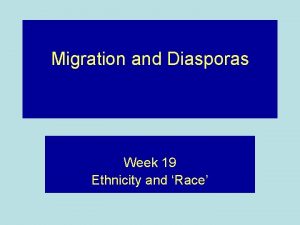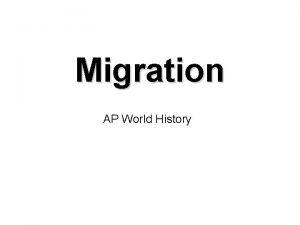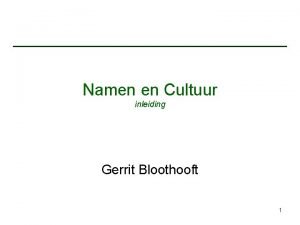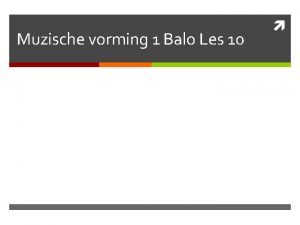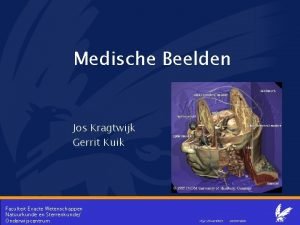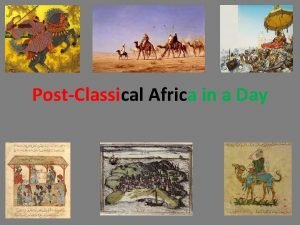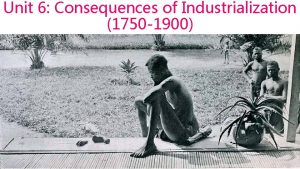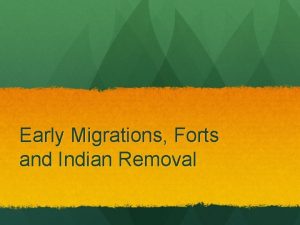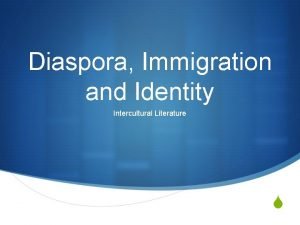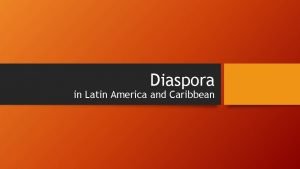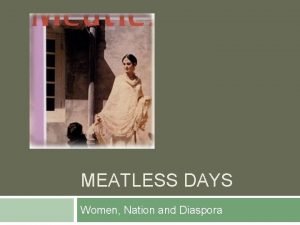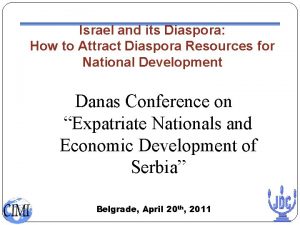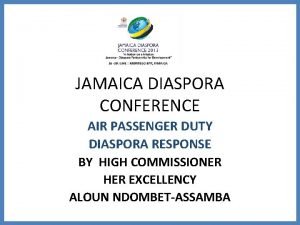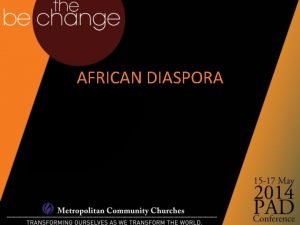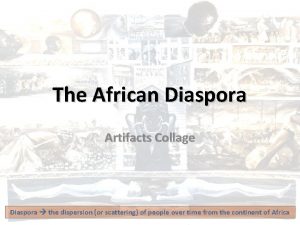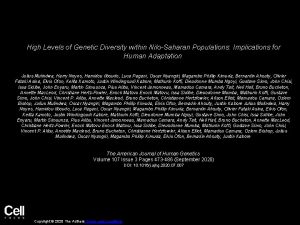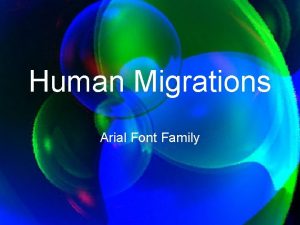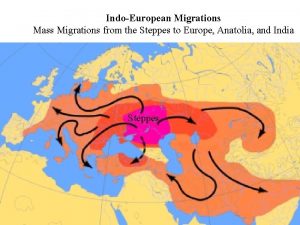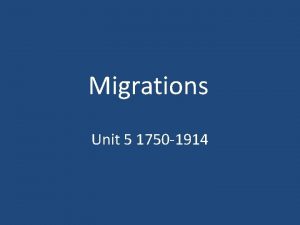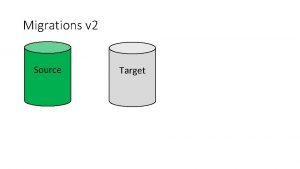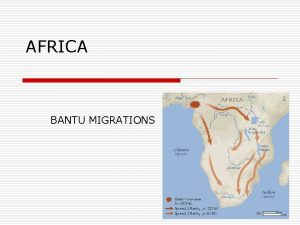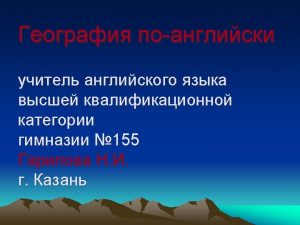Homelands and early migrations The NiloSaharan diaspora Gerrit






















- Slides: 22

Homelands and early migrations: The Nilo-Saharan diaspora Gerrit J. Dimmendaal University of Cologne

Current distribution of Nilo-Saharan (without Songai and Coman plus Gumuz)

• Research within ACACIA project (Arid Climate, Adaptation and Cultural Innovation in Africa), University of Cologne. • Climatological changes – Around 10, 000 BC emergence of a major riverine system, the Wadi Howar or Yellow Nile (Pachur and Kröpelin (1993: 20). – Upper Wadi Howar, the Middle Wadi Howar and the Lower Wadi Howar teeming with flora and fauna roughly between 8500 BC and 1500 BC. – Pastoralism introduced into the area probably as early as 5000 BC. – Desertification setting in around 3000 BC. – Lower Wadi Howar abandoned by 3000 BC. – Middle Wadi Howar abandoned by 2000 BC. • So what has this got to do with the spreading of the Nilo-Saharan phylum?


The principle of least effort • Highest degree of genetic diversity along an westeast axis (Saharan, Maban, For, Kunama, Central Sudanic, Eastern Sudanic) • Eastern Sudanic consists of three subgroups: – The Northern subgroup: • Taman, Nubian, Nyimang plus Dinik, Nara, Meroitic. – The Central subgroup: • Eastern Jebel – Southern subgroup: • Temein plus Keiga Jirru, Daju, Surmic, Nilotic




Typological properties as identified by Heine (1976): • Constituent order: Verb-final in Nilo-Saharan languages ranging from Chad across Sudan towards Ethiopia and Eritrea • Extensive case marking shared with Afroasiatic languages in Ethiopia.


Table 1. Dependent-marking in Nilo-Saharan ________________________ Language group Const. Order Periph. Case ________________________ Saharan V-final yes Maban V-final yes Fur V-final yes Kunama V-final yes Eastern Sudanic Northern group: Nubian Tama Nyimang Central group: Southern group: Daju Temein Nilotic Surmic V-final SVO V 2, V-initial yes yes no highly reduced




Extending the areal typology: • Differential Object Marking as a case-marking strategy (e. g Tigre (Semitic), Dongolese Nubian (Eastern Sudanic, Nilo-Saharan) 1. 2. 3. 4. 5. • obligatory with pronominal objects; obligatory with proper names as objects; obligatory with objects performing the semantic role of Recipient, Beneficiary; not obligatory from a syntactic point of view with object NP’s performing the role of Patient or Theme; excluded with coverbs forming a complex predicate with light verbs (‘do/say’). Light verb plus coverb constructions (‘do/say x’). Compare Nyimang: u nä -s e e 'bow, bend' bow-say j. E r-s E E ‘scatter’ IDEO-say

Converb constructions: ‘having opened the door, having entered the house, having arranged the things, having swept the house, (s)he left’


• Central Eastern Sudanic and Southern Eastern Sudanic groups deviate radically from this typological pattern found in Northern Eastern Sudanic, although remnant features may still be found in the Southern subgroup


• Southern Eastern Sudanic: Strongly head marking at the clausal level (verbal extensions expressing direction, benefactive, instrument etc. ). Compare Maasai: a -I rra g-a a 1 SG-sleep-IT Narok: ABS ‘I sleep at Narok’ a -bo l-o ki 1 SG-open-DAT • • a ro k papa O lb. E n. E father. ABS basket: ABS ‘I open the basket for father’ a -du -i e Enka l. E m 1 SG-cut-INST knife: ABS ‘I cut it with a knife’ Split ergativity with post-verbal (but not pre-verbal) Agents in transitive clauses. Remnants of peripheral case marking, e. g. in Nilotic Nuer: Citation l. E p l. O c Locative l. E b ‘tongue’ l. O Oi ‘heart’

• • Desertification after 3000 BC affected the Wadi Howar area and forced nomadic pastoralists out of this area. The present-day distribution of Eastern Sudanic is a reflex of this diaspora. The earliest speakers of Eastern Sudanic languages probably were pastoralists (Dimmendaal 2007). Northern Eastern Sudanic: Tama Central Eastern Sudanic: Gaam Southern Eastern Sudanic: Daju (Lagowa) Temein Proto-Nilotic Meroitic Gaam (Jebel) Proto-Southwestern Surmic ‘cow’ singular t. EE plural t. EE t. OO t. Og te e n!t. E! *d E tukke ki!tu!k *d Uk ‘milk’ era iig *ira

Structural and lexical borrowing between Nilo-Saharan and Niger-Congo languages (Nuba Mountains, southern Sudan) and between Nilo-Saharan and Afroasiatic (Ethiopian area) For Tama Proto-Southwestern Surmic Proto-Southeastern Surmic Western Nilotic Anywa Proto-Kuliak • • • ‘elephant’ O ar O Or *O Ol * Or. O a a ar *o ||or (plural form) Schadeberg (1981 b: 159) reconstructs a root *-o or for Proto-Heiban (Kordofanian, Niger-Congo). Kinship terminology (grandmother, maternal uncle) Inverting the arguments: How plausible are alternative scenarios, e. g. a diffusion from the southern Sudan? 1. 2. 3. 4. Running against the principle of least effort Climatological conditions missing Pastoralism originated from the north No evidence of borrowing, either lexically or structurally, from Niger-Congo languages in the Nuba Mountains (or Eastern/Southern Cushitic for that matter) into northern Eastern Sudanic groups like Nubian, Nyimang, Taman etc.
 Types of diaspora
Types of diaspora Diaspora grega
Diaspora grega Diaspora grega
Diaspora grega Diaspora grega
Diaspora grega Diaspora grega
Diaspora grega Diaspora ap world history
Diaspora ap world history Start up diaspora
Start up diaspora Diaspora direct investment
Diaspora direct investment Gerrit bloothooft
Gerrit bloothooft De verliefde stieros
De verliefde stieros Gerrit hoogenboom
Gerrit hoogenboom Gerrit van der bijl
Gerrit van der bijl Gerrit kuik
Gerrit kuik Byzantine definition
Byzantine definition Bantu migrations
Bantu migrations Migration
Migration Migration types
Migration types Bantu migrations ap world history
Bantu migrations ap world history Bantu migrations definition
Bantu migrations definition Migratio
Migratio Early cpr and early defibrillation can: *
Early cpr and early defibrillation can: * Hát kết hợp bộ gõ cơ thể
Hát kết hợp bộ gõ cơ thể Frameset trong html5
Frameset trong html5
